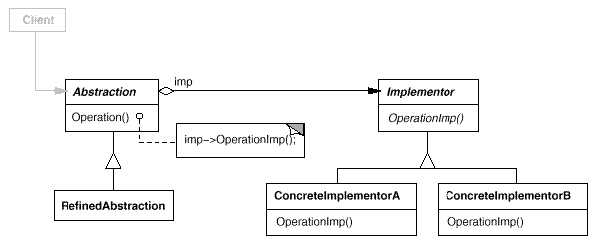Design Pattern ->Bridge
Layering & Contract Philosophy With additional indirection.

class CWindowImp
{
public: virtual void DrawLine(){};
public: virtual void DrawText(){};
}
class CWindow
{
public: virtual void DrawLine(){};
virtual void DrawText(){};
protect: WindowImp* GetWindowImp()
{
return WindowSystemFactory::Instance()->MakeWindwImp();
} ;
private: WindowImp *pWindowImp;
}
class CXPWindow: public CWindow
{
public: void DrawLine()
{
GetWindowImp()->DrawLine();
}
}
class CMacWindow: public CWindow
{
public: void DrawLine()
{
do_something_special; GetWindowImp()->DrawLine();
}
class CXPWindowImp: public CWindowImp
class CMacWindowImp: public CWindowImp
Applicability
Use the Bridge pattern when
- you want to avoid a permanent binding between an abstraction and its implementation. This might be the case, for example, when the implementation must be selected or switched at run-time.
- Layering or interface-Based/Oriented programming. Separate the layer.
- Both the abstractions and their implementations should be extensible by subclassing. In this case, the Bridge pattern lets you combine the different abstractions and implementations and extend them independently.
- Changes in the implementation of an abstraction should have no impact/effect/influence on clients; that is, their code should not have to be recompiled.
- (C++) you want to hide the implementation of an abstraction completely from clients. In C++ the representation of a class is visible in the class interface.
- You have a proliferation of classes as shown earlier in the first Motivation diagram. Such a class hierarchy indicates the need for splitting an object into two parts. Rumbaugh uses the term "nested generalizations" [RBP+91] to refer to such class hierarchies.
- You want to share an implementation among multiple objects (perhaps using reference counting), and this fact should be hidden from the client. A simple example is Coplien's String class [Cop92], in which multiple objects can share the same string representation (StringRep).
Participants
- Abstraction (Window)Defines the abstraction's interface.Maintains a reference to an object of type Implementor.
- RefinedAbstraction (IconWindow)Extends the interface defined by Abstraction.
- Implementor (WindowImp) Defines the interface for implementation classes. This interface doesn't have to correspond exactly to Abstraction's interface; in fact the two interfaces can be quite different. Typically the Implementor interface provides only primitive operations, and Abstraction defines higher-level operations based on these primitives.
- ConcreteImplementor (XWindowImp, PMWindowImp)Implements the Implementor interface and defines its concrete implementation.
Collaborations
- Abstraction forwards client requests to its Implementor object.
Consequences
The Bridge pattern has the following consequences:
- Decoupling interface and implementation. An implementation is not bound permanently to an interface. The implementation of an abstraction can be configured at run-time. It's even possible for an object to change its implementation at run-time. Decoupling Abstraction and Implementor also eliminates compile-time dependencies on the implementation. Changing an implementation class doesn't require recompiling the Abstraction class and its clients. This property is essential when you must ensure binary compatibility between different versions of a class library. Furthermore, this decoupling encourages layering that can lead to a better-structured system. The high-level part of a system only has to know about Abstraction and Implementor.
- Improved extensibility. You can extend the Abstraction and Implementor hierarchies independently.
- Hiding implementation details from clients. You can shield clients from implementation details, like the sharing of implementor objects and the accompanying reference count mechanism (if any).
Design Pattern ->Bridge的更多相关文章
- Design Pattern Bridge 桥设计模式
桥设计模式事实上就是一个简单的has a relationship.就是一个类拥有还有一个类,并使用还有一个类实现须要的功能. 比方遥控器和电视之间能够使用桥设计模式达到能够使用同一个遥控器控制多台电 ...
- 说说设计模式~大话目录(Design Pattern)
回到占占推荐博客索引 设计模式(Design pattern)与其它知识不同,它没有华丽的外表,没有吸引人的工具去实现,它是一种心法,一种内功,如果你希望在软件开发领域有一种新的突破,一个质的飞越,那 ...
- 设计模式(Design Pattern)系列之.NET专题
最近,不是特别忙,重新翻了下设计模式,特地在此记录一下.会不定期更新本系列专题文章. 设计模式(Design pattern)是一套被反复使用.多数人知晓的.经过分类编目的.代码设计经验的总结. 使用 ...
- [转]Design Pattern Interview Questions - Part 4
Bridge Pattern, Composite Pattern, Decorator Pattern, Facade Pattern, COR Pattern, Proxy Pattern, te ...
- [转]Design Pattern Interview Questions - Part 1
Factory, Abstract factory, prototype pattern (B) What are design patterns? (A) Can you explain facto ...
- C++ Design Pattern: What is a Design Pattern?
Q: What is a Design Pattern? A: Design Patterns represent solutions to problems what arise when deve ...
- Design Pattern in Simple Examples
Instead of defining what is design pattern lets define what we mean by design and what we mean by pa ...
- java设计模式大全 Design pattern samples in Java(最经典最全的资料)
java设计模式大全 Design pattern samples in Java(最经典最全的资料) 2015年06月19日 13:10:58 阅读数:11100 Design pattern sa ...
- [转]Design Pattern Interview Questions - Part 2
Interpeter , Iterator , Mediator , Memento and Observer design patterns. (I) what is Interpreter pat ...
随机推荐
- POJ1060 Modular multiplication of polynomials
题目来源:http://poj.org/problem?id=1060 题目大意: 考虑系数为0和1的多项式.两个多项式的加法可以通过把相应次数项的系数相加而实现.但此处我们用模2加法来计算系数之和. ...
- liunx postfix与sendmail 开启与关闭
1:检查sendmail服务的状态 service sendmail status 2:开启sendmail服务 service sendmail start 3:关闭sendmail服务 servi ...
- [NOI2009]管道取珠(DP)
Luogu1758 DarkBZOJ1566 题解 因为他要让我们求出每种状态出现次数的平方和,这样模拟两人取球的时候,设第一个人取球的方案为A,第二个人取球的方案为B, 这样对于每一个A,都有C(n ...
- nodejs創建目錄命令mkdir失敗
Windows系統 學習nodejs創建目錄命令:mkdir var fs = require('fs'); fs.mkdir('./tmp/test',function (err) { if(err ...
- linux学习五
一.系统服务管理 1.概念 服务(service) 本质就是进程,但是是运行在后台的,通常都会监听某个端口,等待其它程 序的请求,比如(mysql , sshd 防火墙等),因此我们又称为守护进程,是 ...
- KS光盘制作 for rhel6.5 and rhel7.2
############################## RHEL6.5 KS光盘制作--1.复制光盘到本地mkdir -p /opt/rhel6mount /dev/cdrom /mediacp ...
- Linpack之HPL测试
平台信息 Description: CentOS Linux release 7.6.1810 (Core) 注意事项 安装HPL之前需要配置好: GCC/Fortran77 编译器 BLAS/CBL ...
- Mybatis学习笔记8 - resultMap自定义结果集映射规则
一.resultMap自定义结果集映射规则 示例如下: 接口定义: package com.mybatis.dao; import com.mybatis.bean.Employee; public ...
- BP人工神经网络-反向传播法
0 网络计算结果 B(m)=f( ∑n( W(n,m)*X(n) ) + Θ(m) ) %中间层的输出 Y(k)=f( ∑m( V(m,k)*B(m) ) + ф(k) ) %输出层的输出 1 计算误 ...
- (转)shell中各种括号的作用()、(())、[]、[[]]、{}
shell中各种括号的作用().(()).[].[[]].{} 原文:http://www.jb51.net/article/60326.htm http://blog.csdn.net/good_h ...
